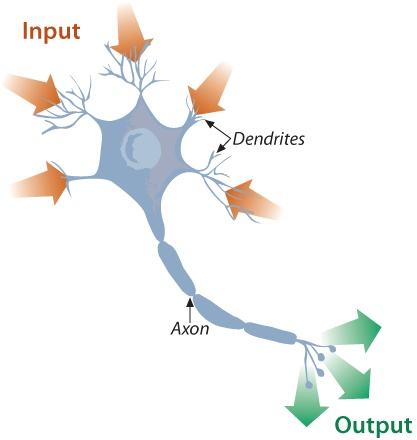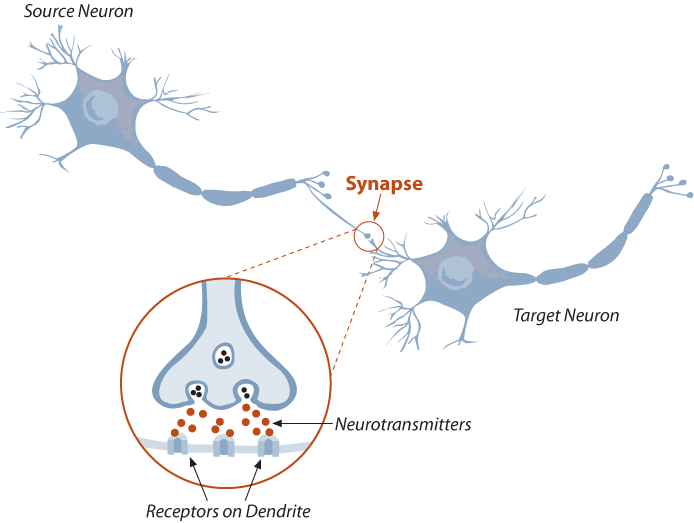So far, you've looked at the brain's shape, structure, and history. But you haven't yet seen it in action.
You probably already know that the brain is an electrical appliance more complex than any circuit board. But the brain also communicates with chemicals, using tiny compounds to transmit information, control mood, and interact with the rest of the body. Once you understand a few facts about your brain's wiring system, you'll have an easier time tackling some of the more sophisticated topics in this book.
Your brain holds hundreds of billions of nerve cells. These cells come in two flavors: neurons (which get all the attention) and glial cells (which play an essential but often-overlooked supporting role).
Neurons carry electrical signals through your brain, and through the rest of your body. Estimates range, but the most widely cited calculations suggest that you have 100 billion neurons. (If you need an ego boost, compare that with the 300,000 neurons in the brain of the humble fruit fly.) Amazingly, there are at least 10 times as many glial cells, which provide nourishment, protection, waste disposal, speed enhancement (see Wiring the Brain), and other support services for the spotlight-hogging neurons.
Here's a look at a single neuron:
Up close and personal, a neuron looks like some form of futuristic vegetation. It receives messages through tree-like branches called dendrites. It then sends an electrical signal down a long tube-like structure called the axon. Add up the cumulative effect of several billion of these electrical impulses and you get a symphony, a treatise on law, or an episode of Buffy the Vampire Slayer.
The real magic happens when an electrical signal reaches the end of a neuron. At this point the neuron releases a bundle of chemicals into a tiny gap called a synapse. These chemicals, known as neurotransmitters, drift through the synapse (essentially "swimming" in the fluid of your brain) until they reach the dendrite of another neuron. That neuron can then react by firing its own electrical signal. In this way, a message can ricochet through the human brain, passing from one neuron to another.
As you might expect, this description is a huge simplification of the messy reality taking place inside your cranium. Here are some of the reasons why the brain's wiring system quickly becomes more complicated:
The brain uses different types of neurotransmitters, which affect different neurons. Estimates suggest that the brain is a chemical soup, using more than 100 different substances to communicate between neurons.
An average neuron connects to several thousand other neurons. That means thousands of neurons can simultaneously influence whether a single target neuron fires its signal. Similarly, one active neuron can pass its signal on to thousands more. It all adds up to a very flexible wiring system.
Neurotransmitters don't just trigger a neuron to fire. They can also inhibit a neuron from firing.
Neurotransmitters don't just carry signals between neurons. They can also act as neuromodulators to perform a host of different tasks. For example, a neuromodulator can alter the way a neuron works, change its sensitivity, trigger the creation of new proteins, and drift out of the tiny synaptic gap to affect entire regions of the brain. Many compounds in the brain act as ordinary message-carrying neurotransmitters in some situations, but behave like more powerful neuromodulators in others.
Note
Neuromodulators may play a role in memory, learning, and mood control. For example, antidepressive drugs like Prozac work by increasing brain levels of serotonin, which can act as a neuromodulator. This change affects the way that billions of brain neurons work, in ways even the sharpest scientists don't currently understand.
If you could scoop out a small lump of your jelly-like brain matter and examine it under the microscope, you'd find a dense thicket consisting of millions of neurons, with dendrites and axons crossing and interweaving in an impossibly tangled fabric. It's estimated that the total number of connections between neurons (that is, the total number of synapses in the human brain) is in the eye-popping tens of trillions. It's for this reason that the human brain is sometimes described as the most complex object we've ever discovered in our universe. You should feel flattered.
Often, we think of the human brain as a single deviceâa sort of biological computer made out of water, fat, and DNA. But the brain is actually a multi-pronged organ whose influence extends far beyond the head. In fact, the long tentacles of dendrites and axons stretch right out of the brain and into nearly every corner of the human body, uniting every muscle and organ into a body-wide network called the nervous system.
So far, you've learned how neurons can pass information between themselves. But the neurons on the outskirts of the nervous system get their input from something else. Depending on the type of neuron, they may fire signals in response to changes in heat, pressure (used for the sense of touch and sound), chemicals (for taste and smell), or light (for vision). These signals are then ferried up through the spinal cord to the brain. For example, a touch on your toe runs through just two giant neurons to reach your brain.
Similarly, an outgoing chain of neurons lets your brain send messages to the far corners of your body. When your brain needs to exert its control over a body partâeither consciously or unconsciouslyâit simply triggers the right combination of neurons. The last neuron in the chain triggers the release of a chemical that kicks off the desired body process in another cell.
For example, if you stub your toe while line dancing, nearby neurons detect the deformation of your skin. These neurons pass the message up to the brain, which interprets this electrical activity as head-slapping agony. Your brain then triggers the neurons that will jerk the foot away. The last neurons in this sequence release a neurotransmitter to some nearby muscle tissue, compelling your muscles to contract and move your leg.
Of course, the low-level story is far more detailed. Even the simplest response involves many different neurons. For example, as you jerk your leg away using one group of muscles, you brain needs to relax another muscle group to prevent injury. Furthermore, the nervous system reacts to many different types of neurons in the same area of the body. This is one of the reasons that humans are "blessed" with so many types of pain. The dull ache of damaged tissue is picked up by a neuron that reacts to chemical changes, the flash of pain from a burn is triggered by neurons that react to extremely high heat, the sting of a cut is caused by neurons that react to the incision, and so on.
As you've learned, your brain pulls all the strings. It controls a vast range of body processes simply by signaling the right neurons. However, neurons don't stretch everywhere, and they aren't nuanced enough to take every interaction into account. For that reason, your brain has another system that allows it to control the bodyâthe endocrine system.
The endocrine system consists of a group of small organs known as glands. These glands work their magic by secreting various chemicals (called hormones) into your bloodstream. These hormones trigger reactions in other body parts. For example, the thyroid gland controls the speed of your metabolism. The adrenal gland controls the "fight or flight" responseâit fires you up into a state of acute stress when an SUV steals the mall's last parking spot on Christmas Eve.
Much as the brain rules the nervous system, it's also the master of the endocrine system. Its key control mechanism is the pituitary gland.
To communicate with the glands in your body, the brain needs to release hormones into your blood. Its job is complicated by a defensive wall called the blood-brain barrier, which separates your brain from your bloodstream. The blood-brain barrier prevents most toxins, bacteria, viruses, and hormones from passing into the brain. The only substances that can pass through are extremely small ones, or ones that are soluble in fat. Fortunately, oxygen, alcohol, and caffeine make the cut. Other compounds need to be ferried across by specialized transporters. (One example is glucose, the sugar molecule that supplies energy to your brain.)
Much as the blood-brain barrier locks substances out of your brain, it also prevents substances from passing from your brain into your blood. To get around this limitation, the brain uses a built-in hormone dispenser called the pituitary gland. This pea-sized gland hangs out of the bottom of the brain, allowing it to slip hormones into your bloodstream whenever your brain gives the signal.
Note
The pituitary gland is often called the master gland, because it releases the hormones that tell the other glands (like the thyroid and adrenal glands) what to do. In this way, your brain can use the pituitary gland to exact precise control over the state of your body.
Although you may have vaguely heard about the pituitary gland before, it's already had a profound effect on your life. The brain uses the pituitary gland to release life-changing hormones at key points in your life. These hormones trigger growth and sexual development (as you'll see in Chapter 9), the contractions of birth, and milk production. Clearly, your brain is in charge of a lot more than you might have expected.
Incidentally, the part of the brain that controls the pituitary gland is the hypothalamus. You'll meet the hypothalamus several times in this book, starting in Chapter 2 (The Secret Gears of Appetite).
Get Your Brain: The Missing Manual now with the O’Reilly learning platform.
O’Reilly members experience books, live events, courses curated by job role, and more from O’Reilly and nearly 200 top publishers.




